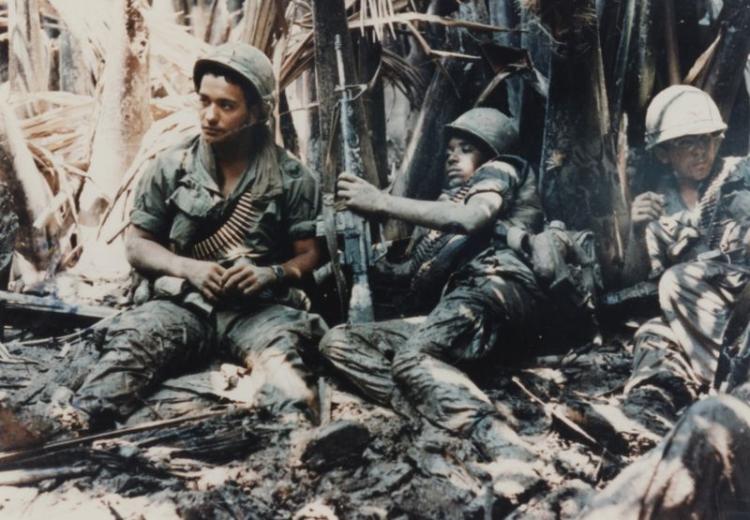The Things They Carried: Tim O’Brien’s Vietnam War Novel Endures

Privates First Class Carl Baden (New Orleans, Louisiana) and Arcadio Carrion (Puerto Rico) laying in the mud waiting for artillery to knock out the machine gun bunker that has them pinned down in a tree line at My Tho (April 4, 1968).
Fifty years ago, many young men like Tim O’Brien, author The Things They Carried—published in 1990—were drafted into the army and later served in what was increasingly becoming an unpopular war. Today, in times of a volunteer army, many aspects of the military have changed. For one thing, women now serve in combat roles, too.
Critics have hailed The Things They Carried as one of the finest examples in American literature of writing about war. O’Brien served in Vietnam from 1969 to 1970, and, in The Things They Carried, wrote a collection of linked stories that reads like a memoir. A character introduced in one story will appear in a later one, and even though they’re all linked in some way, each story can stand on its own. The title story is an overture and creates the world of Vietnam for readers. The story also establishes the physical weight of objects each soldier carries by choice or by regulation. Later in the novel, however, the things they carry are psychological. In the opening story, the repetition of the phrase “the things they carried” becomes haunting, and it unifies the experience for the reader, who begins to feel the weight of objects the soldiers carried.
Each character in the novel’s opening story carries, along with those articles that were SOP (standing operating procedure), personal items that often serve as a talisman or a salve for the grueling psychological effects of battle. Additionally, O’Brien writes, “they carried ghosts.”
In World War II, the average age of an American soldier was the mid-twenties, while that of soldiers in Vietnam was nineteen. The young soldiers in Vietnam were especially susceptible to the psychological pressures of combat.
Drafted in the summer of 1968, O’Brien himself is a character in the novel, acting primarily as narrator but also, significantly, as the principal character in one story. In “On the Rainy River,” O’Brien sets off to his home state’s northern border with Canada. There, along the Rainy River’s southern banks in Minnesota, O’Brien contemplates fleeing the draft and slipping into Canada. In an interview, O’Brien has talked about the story and its relation to actual facts. An author “plays with facts,” he says, in order to get to the truth.
O’Brien himself never spent days along the Canadian border, contemplating and seriously considering life as a draft dodger. Instead, he played golf that summer in southern Minnesota, but the anxiety of having to report to his induction base a few weeks later produced a tightness in his chest similar to that felt by the fictional O’Brien, who finally decides not to dodge the draft. “On the Rainy River” raises philosophical questions for students concerning the true meaning of courage.
Students who have read novels set in times of war, such as, among others, The Naked and the Dead by Norman Mailer (published in 1948) can make useful comparisons and contrasts with The Things They Carried. Mailer’s groundbreaking WW II novel, as does The Things They Carried, presents the reader with a cross section of soldiers serving in war. Readers and critics often note that both Mailer and O’Brien have written with journalistic detail. A comparison of the two authors’ use of the same techniques can help students talk about the various ways novelists can present the experience of war.
In interviews, OBrien speaks of a “stomach feeling” he wants to leave with his readers. He doesn’t sanitize details. Students who may have read Johnny Got His Gun (published in 1939) can discuss the “stomach feeling” they may have had from reading the novel by Dalton Trumbo.
When O’Brien was writing The Things They Carried in the late 1980s, American women were not serving in combat roles, although, as Ken Burns and Lynne Novick’s documentary The Vietnam War demonstrates, in the war without a front, many women did serve in Vietnam as nurses near combat and at medical bases. Since 2015 women in the military can serve in combat zones.
The story “Sweatheart of the Song Tra Bong” was, O’Brien says, a “heuristic exercise.” By a kind of storyteller’s trial and error, he decided to try to craft a story that interjects a woman (the girlfriend of the medic, Rat Kiley) into the combat experience, first as the traditional girl next door in a pink sweater, who is improbably visiting Kiley in Vietnam, to a night-stalking member of a Green Beret unit. She goes native, echoing, admits O’Brien, The Heart of Darkness by Joseph Conrad. Students can consider to what extent O’Brien’s story does or does not still ring true, now that women serve in combat, too, and are also beginning to write about their war experiences, as female veterans discussed recently in Bethlehem, Pennsylvania, in a writing workshop reported on in the Washington Post.
O’Brien’s success in creating for readers an authentic experience of war stems from a variety of techniques and styles, including linked stories, milieu-setting detail, and a cross section of well-drawn characters. The novel can serve either as an introduction to war lit generally or as a useful tool to further build on the writings on war students may have already encountered.
